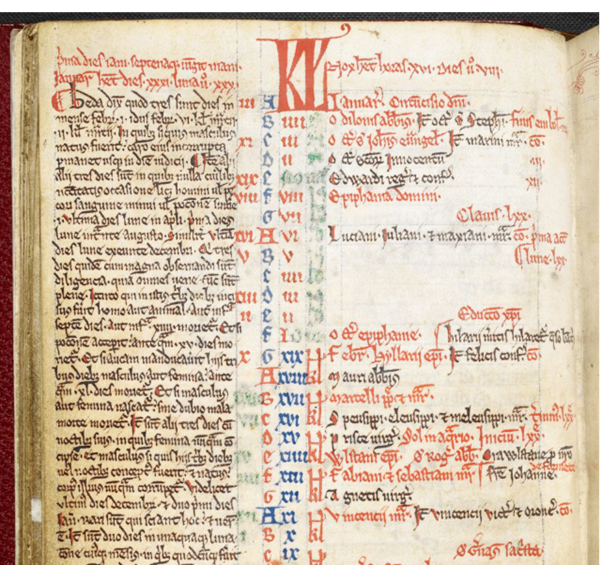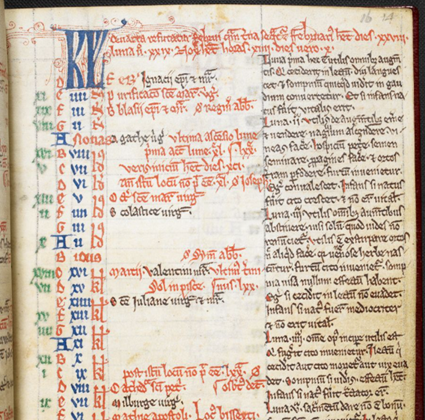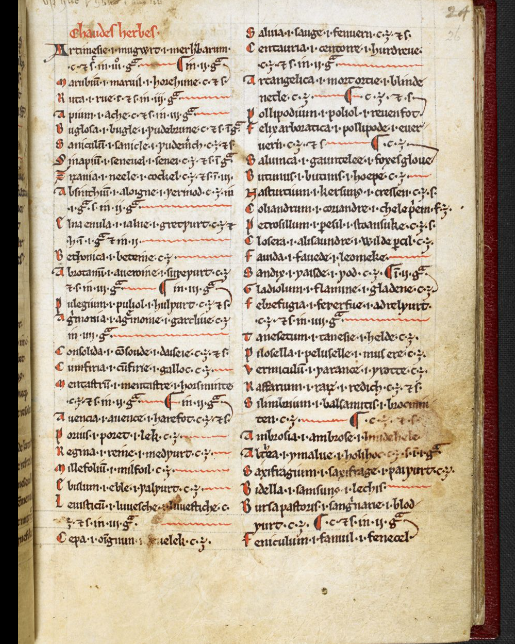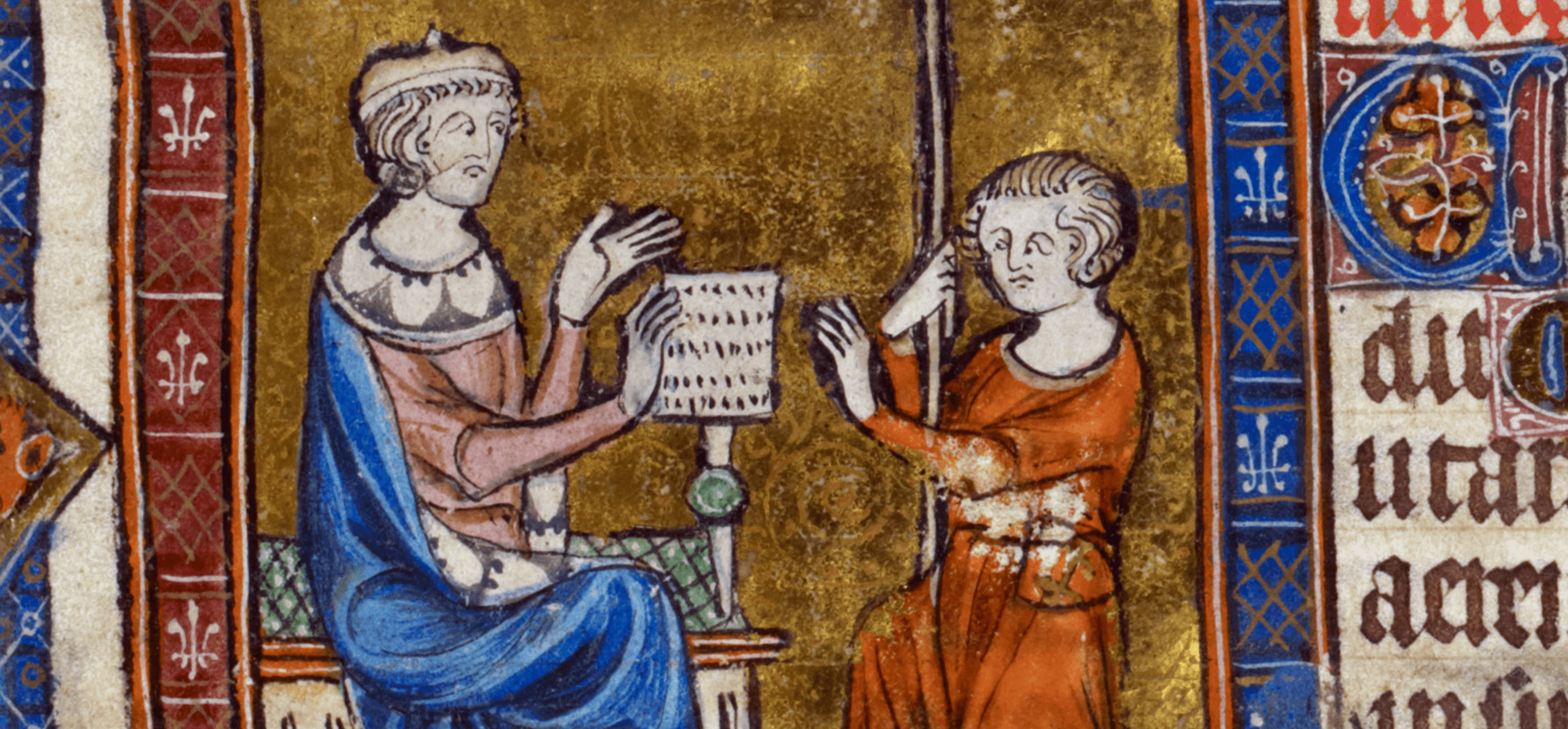Written by Anne Lawrence-Mathers, Professor of Medieval History, Reading.
Immediately after the collection of songs and music in this extraordinary manuscript comes a collection of medical and magical texts.
They start, surprisingly, with a calendar, which has saints’ days filled in for the first few months. However, as shown in the image below, this is no standard calendar.
A magical calendar

The standard entries for the dates, the days on which saints were commemorated, and the deaths of members of the abbey community have been squeezed towards the centre of the volume. In the middle of the top line for each month is a large ‘KL’ symbol, marking the first day of the month (which were known as kalends). Beside each, in red, is a note of how many hours of light and of darkness each period of twenty-four hours has: sixteen night hours and eight day hours in the case of January, on the left above.
The outer margins are unusually wide and have, what might be considered as, magical contents. The two lines of red text in the top left corner of the January page say in Latin that the first day of the month and the seventh from last are very significant (and possibly dangerous) for health. Below that, also in Latin, comes a short text claiming (falsely) that Bede, the Anglo-Saxon monk, theologian and scientist of the abbey of Wearmouth-Jarrow, had identified three days in February as miraculous days for babies to be born. Any boy born on one of these three days would have flesh which would remain free from any decay until the day of Judgement!
Next comes another piece of information supposedly from Bede. This one says that there are another three days on which nobody should receive medical treatment or take medicine, because it would be fatal. These are spread out between April, August and December, but are complicated to identify for any given year because they require the user of the calendar to find the first and last days of lunar months occurring near specified points in the calendar months. It is followed by lists of other miraculous or dangerous days. For instance, anyone who eats goose meat on certain days will die within 40 days, while another three guarantee a bad death to anyone born during them! The scribe notes: ‘Not many people know this, and it is true’.
The mention of the months of the moon links this note to the longest texts written in the calendar margins, which are sets of predictions linked to days of a lunar month. Lists like this appear superstitious or magical but seem to have been accepted in the medieval period as based on long experience, or on classical knowledge.

This image shows the upper part of the calendar page for February. The text in black ink in the right-hand margin is the list of days in a lunar month and their powers. It begins ‘Luna prima’ (‘First day of the Moon’). This day is ‘useful for starting things which are to grow’. Things seen in dreams on this day will lead to happiness. And if a child is born it will be strong and healthy. But if anyone falls seriously ill and takes to their bed they will remain sick for a long time.
Clearly, knowing which days of a lunar month were favourable or dangerous for certain types of activity could be very valuable. For instance, in June, the 5th and the 30th days of the lunar month were to be avoided by anyone starting a new enterprise – if this advice were ignored then the undertaking would be completed only very late, or even never.
The idea that such strange advice came from the ancient world is repeated by the collection of health advice which starts in folio 22. It begins with a letter, claiming to have been written by none other than the philosopher, Aristotle, for the guidance of Alexander the Great. The image below (from a manuscript made in 14th century England, BL Ms Add. 47680, fol.10) shows Aristotle sending such a letter to Alexander. Alexander supposedly replied, sending information on the marvellous places and wonderful things he had seen on his military expeditions.

From Ibn Sina to Hippocrates
Access to a range of medical works is shown by the next extract: a treatise by the polymath Persian physician, astronomer and philosopher Ibn Sina (known in the medieval west as Avicenna), one of the most prominent philosophers of the Islamic Golden Age.

This is followed, more worryingly, by a list of signs of impending death! Since this text was written in both Latin and French, it was clearly meant to be a useful reference for secular readers as well as monks. Strange it may seem, but these short texts appear to have been intended for practical use, and are followed by a useful list of medical herbs. Here too, communication with people who did not know Latin is clearly important. The names of the herbs are given in Latin, French and English. The opening page features the heading ‘Chaudes herbes’ (hot herbs), and continues into ‘cold herbs’ and spices, before imparting medical recipes and a long medical treatise attributed to Hippocrates. All of this medical guidance is given in French, not in Latin.
The first entry on the list is Artemisia, which is given the English name of Mugwort. Herbals advised on the use of the dried leaves as rubs and ointments to cure a range of skin conditions as well as gall stones. It was also used as an insect repellent.
This collection of useful medical information seems to be the personal selection of someone who was widely read in such works, and who expected to discuss medical matters with speakers of both French and English. He was not a medical professional but could reassure or impress those he was advising by referring to such famous authorities as Aristotle and Hippocrates. What this section of the manuscript seems to provide is an abbreviated survey of accepted medical guidance on both the maintenance of health and of the most effective forms and times for medical interventions.





